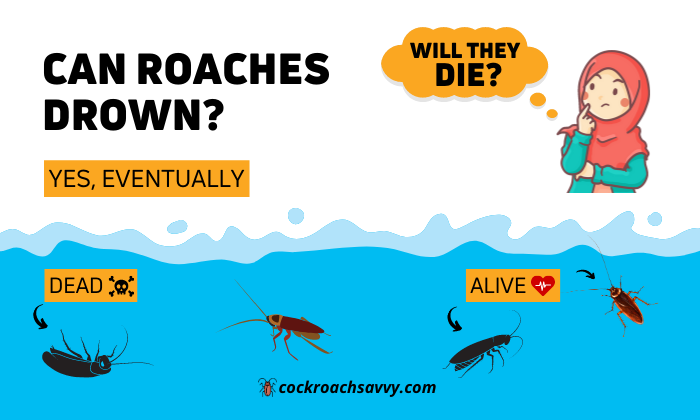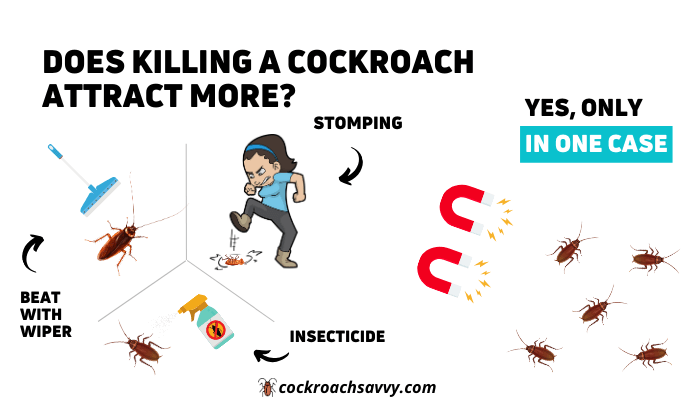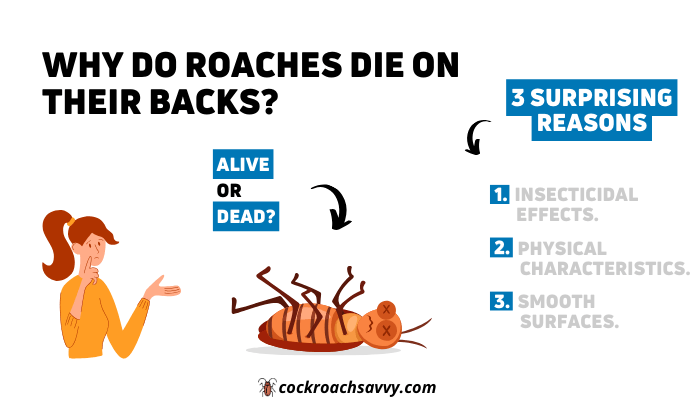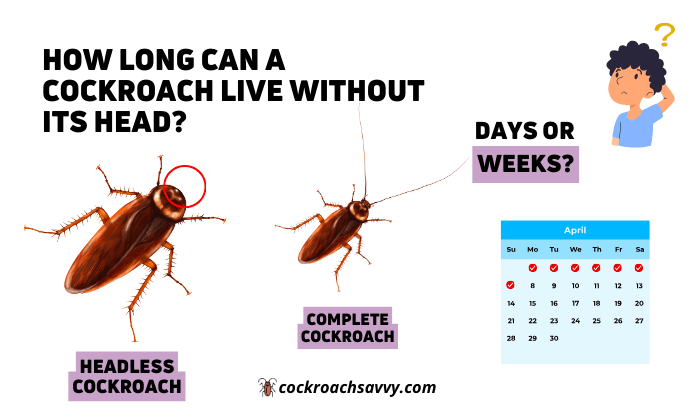As you probably know, cockroaches are known for their remarkable survival abilities.
These resilient creatures can thrive in various environments, and their ability to withstand extreme conditions is truly fascinating.
One interesting aspect of cockroach survival is their ability to survive in water.
These insects can manage to stay underwater for an impressive 30 minutes without the need for oxygen.
But can they be killed if drowned longer than 30 min?
In this article, we will explore the intriguing world of cockroach respiration, why it is difficult to drown roaches and answer some interesting frequently asked questions.
Let’s start drowning them!
Can Cockroaches Drown?
The answer is yes, cockroaches can drown.
However, it’s not as easy as you might think.
These pests have some impressive adaptations that make drowning a challenging feat.
Let’s dive deeper into why it’s so difficult to drown a cockroach.
Why is it hard to drown roaches?
Drowning roaches can be challenging due to the following advantages inherent in roaches’ instincts:
1. Unique Respiratory System of Roaches:
Cockroaches have a unique respiratory system that sets them apart from many other insects.
Instead of relying on lungs to breathe, they utilize a network of tiny tubes called tracheae.
These tubes deliver oxygen directly to their cells, allowing them to survive without the need for a centralized respiratory organ.
When a cockroach is submerged in water, its tracheal system helps it hold its breath.
The tiny tubes contain air, and by closing their spiracles (small openings on their body), cockroaches can prevent water from entering their respiratory system.
This ability enables them to survive underwater for an astonishing 30 minutes without feeling a need for oxygen.
2. Roaches’ Ability to Hold Their Breath:
In addition to their unique respiratory system, cockroaches have another fascinating adaptation that aids in their survival in water.
They can hold their breath for 30 minutes underwater and 40 minutes on land.
When a cockroach falls into water, it will trap air inside its body.
This trapped air acts as a buoyancy aid, allowing the roach to float on the water’s surface instead of sinking to the bottom.
By holding their breath and floating, cockroaches can increase their chances of finding a way out of the water.
Their strong survival instincts kick in, and they employ their climbing skills to try and escape the watery trap.
3. Strong Climbing Skills:
Cockroaches are notorious climbers.
They possess specialized leg structures that allow them to scuttle up vertical surfaces and even traverse ceilings with ease.
When submerged in water, they will instinctively try to climb out by using these remarkable climbing skills.
This behavior is especially noticeable when no external force is submerging them.
However, it’s important to note that if a cockroach remains underwater for an extended period or if it is forcibly held down, it will eventually succumb to drowning.
While they can withstand submersion for a remarkable duration, it is not an indefinite ability.
Factors Affecting Cockroach Drowning Time:
Several factors influence a cockroach’s ability to drown, ultimately impacting the duration it takes for them to succumb to submersion
Depth and Duration of Submersion:
The depth and duration of submersion play a crucial role in a cockroach’s survival.
Shallow water and shorter periods of submersion give roaches a better chance of survival, as they can conserve oxygen for a longer duration.
In deeper water or when submerged for an extended time, their chances of drowning increase significantly.
The longer and deeper the submersion, the greater the risk of drowning.
Species of Cockroach:
Different species of cockroaches exhibit varying levels of resistance to drowning.
Some species have better adaptations and higher tolerance for submersion, making them more adept at surviving in water.
For example, the American cockroach and Oriental cockroach are generally more resilient to drowning compared to other species.
However, it is important to note that no cockroach species is completely immune to drowning, and their ability to survive underwater still depends on other factors such as temperature and duration of submersion.
Physical Condition of the Cockroach:
The physical condition of a cockroach can impact its ability to survive in water.
A healthy and robust roach may have a better chance of enduring submersion compared to a weakened or injured one.
Cockroaches with damaged or compromised respiratory systems, such as those affected by pesticides or respiratory infections, are more susceptible to drowning.
Does Hot Water Kill Roaches?

While we’ve explored the difficulty of drowning cockroaches, what about hot water?
Can it be an effective method to kill these resilient pests?
Hot water can indeed kill cockroaches, but complete submersion is necessary.
And here, It’s the heat that kills them, not the water itself.
Roaches cannot survive temperatures over 125 degrees Fahrenheit (52 degrees Celsius) when directly exposed.
Merely splashing hot water may hurt them, but not kill them.
For effective elimination, roaches need to be fully submerged and exposed to these high temperatures for more than a few seconds to ensure their demise.
Can you drown a cockroach?
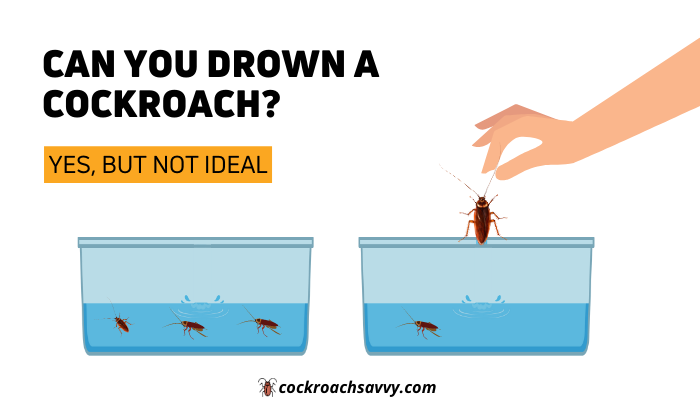
In general, it is possible to drown a cockroach.
However, drowning roaches solely for the purpose of getting rid of them is not practical.
While it may be intriguing to experiment with drowning roaches, it’s important to consider more effective methods like natural roach repellents or Lysol disinfectant spray to get rid of them.
That being said, due to their remarkable adaptations and survival instincts, drowning roaches can be quite challenging.
An interesting experiment was conducted where cockroaches were submerged in a glass full of water, and it was observed that they held their breath.
When the roaches were taken out of the water, they appeared lifeless, as roaches are skilled at playing dead.
However, when left to soak overnight, some of the roaches were surprisingly still alive in the morning.
It turns out that when they were taken out of the water, they were not dead but rather pretending to be dead.
While cockroaches have impressive resistance to submersion, prolonged exposure or forced submersion will eventually lead to their demise.
Can Cockroaches Swim Underwater?
While cockroaches can survive underwater for a limited time, they are not natural swimmers.
When submerged, they employ a unique mechanism to stay afloat and find their way out of the water.
Cockroaches have spiracles, which are tiny breathing openings on their bodies.
By sealing up these spiracles, they can hold air inside their body, causing them to float on the water’s surface.
In a state of panic, the roach will paddle its legs in a frantic scramble, which can help it navigate towards the edge of a container or the opening of a drain.
Although underwater, the roach may be able to paddle around to some extent, but its mobility is limited.
It’s important to note that while cockroaches can float and paddle in the water, they rely on these mechanisms rather than true swimming abilities to survive submerged conditions.
Wrapping Up – Roaches Drowned And Died
Now, Let’s Drown this Article – Just Joking…
In the end, all I have to say is while cockroaches have incredible abilities to survive in various conditions, they are not invincible.
Despite their adaptations to water, they can be drowned if the conditions are right.
Their unique respiratory system, ability to hold their breath, and strong climbing skills make them formidable opponents in their quest for survival.
FAQS
Do Cockroaches Die in Water?
Cockroaches are incredibly resilient and can survive in water for a significant period.
While they don’t die easily in water, extended submersion can eventually be fatal.
Cockroaches have a unique respiratory system called the tracheal system, which allows them to hold their breath and float on the water’s surface by trapping air in their bodies.
Factors such as water temperature, submersion duration, and cockroach species can influence their survival.
How long does it take for a cockroach to drown?
The time it takes for a cockroach to drown depends on several factors, including the species, water temperature, depth, and duration of submersion.
While cockroaches can survive underwater for up to 30 minutes, prolonged exposure or forced submersion will eventually lead to their drowning.
Can roaches breathe underwater?
Cockroaches cannot breathe underwater in the same way they do on land as they don’t possess any gills like most aquatic animals do.
Instead, they rely on their tracheal system, a network of tiny tubes that deliver oxygen directly to their cells.
However, their unique respiratory system and ability to hold their breath allow them to extract sufficient oxygen to survive underwater for a limited period.
Is it possible to kill roaches by drowning them?
Yes, it is possible to kill roaches by drowning them.
However, due to their ability to hold their breath, it can be challenging to drown them.
Prolonged submersion or forced drowning can eventually lead to their demise.
Can You Flush A Cockroach?
Flushing a cockroach down the toilet can be an effective way to remove them from your immediate vicinity.
However, it is not a guaranteed method of killing them, as cockroaches have the remarkable ability to hold their breath for approximately 30 minutes.
This means that when you flush them, they may find a way to survive and potentially make their way back to your washroom or escape through the toilet pipes, leaving them alive and able to reappear later.
How Long Can Cockroaches Survive Without Air?
Cockroaches can survive without air for varying periods depending on their species, environmental conditions, and available oxygen stored in their bodies.
They have the ability to hold their breath for an extended time, allowing them to survive for approximately 30 minutes underwater and up to 40 minutes on the surface.
However, their survival is ultimately limited without a fresh supply of oxygen to sustain their vital functions.

